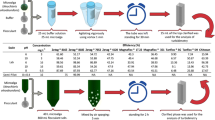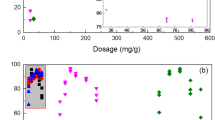Abstract
Flocculation of three freshwater algae, Spirulina,Oscillatoria and Chlorella, and onebrackish alga, Synechocystis, using chitosan was studiedinthe pH range 4 to 9, and chlorophyll-a concentrations inthe range 80 to 800 mg m−3, which produces aturbidity of 10 to 100 nephelometric turbidity units (NTU) in water. Chitosanreduced the algal content effectively by flocculation and settling. Theflocculation efficiency is very sensitive to pH, and reached a maximum at pH7.0for the freshwater species, but lower for the marine species. The optimalchitosan concentration that is required to effect maximum flocculation dependedon the concentration of alga. Flocculation and settling were faster whenconcentrations of chitosan higher than optimal are used. The settled algalcellsare intact and live, but will not be redispersed by mechanical agitation. Thede-algated water may be reused to produce fresh cultures of algae.
Similar content being viewed by others
References
Clasen J., Mischke U., Drikas M. and Chow C. 2000. An improved method for detecting electrophoretic mobility of algae during destabilization process of flocculation: flocculant demand of different species and the impact of DOC. Aqua 49: 89-101.
Eaton A.D., Clesceri L.S. and Greenberg A.E. (eds) 1995. Standard Methods for the Examination of Water and Waste Water. American Public Health Association, Washington, DC, USA.
Faust S.D. and Aly O.M. 1983. Chemistry of Water Treatment. Butterworths, 137-139, 699.
Hejzlar J., Dolejs P., Komarkova J., Seda J., Simek K. and Vyhnalek V. 1998. Effect of biomanipulation on the structuring of the planktonic food web and water treatability by coagulation. Water Sci. Technol. 37: 105-112.
Liu J.C., Chen Y.M. and Ju Y.H. 1999. Separation of algal cells from water by column flotation. Sep. Sci. Technol. 34: 2259-2272.
Muzzarelli R.A.A. 1977. Chitin. Pergamon Press Ltd., Oxford, 247–253, 207-211.
Nurdogan Y. and Oswald W.J. 1996. Tube settling of high-rate pond algae. Water Sci. Technol. 33: 229-241.
Oufdou K., Mezrioui N., Oudra B. and Ouhdouch Y. 1998. Experimental study of the effect of Synechocystis sp. (picocyanobacteria) on the behaviour of some bacteria of sanitary interest. Annales de Limnologie - Int. J. Limnol. 34: 259-268.
Pan J.R., Huang C.P., Chuang Y.C. and Wu C.C. 1999. Dewatering characteristics of algae-containing alum sludge. Colloids Surf., A 150: 185-190.
Steynberg M.C., Adam K. and Pieterse A.J.H. 1998. An algal monitoring protocol: The strategic link between reservoir and treatment processes. Water Sci. Technol. 37: 153-159.
Whitehead P.G., Howard A. and Arulmani C. 1997. Modeling algal growth and transport in rivers: a comparison of time series analysis, dynamic mass balance and neural network techniques. Hydrobiologia 349: 39-46.
Author information
Authors and Affiliations
Rights and permissions
About this article
Cite this article
Divakaran, R., Sivasankara Pillai, V. Flocculation of algae using chitosan. Journal of Applied Phycology 14, 419–422 (2002). https://doi.org/10.1023/A:1022137023257
Issue Date:
DOI: https://doi.org/10.1023/A:1022137023257




